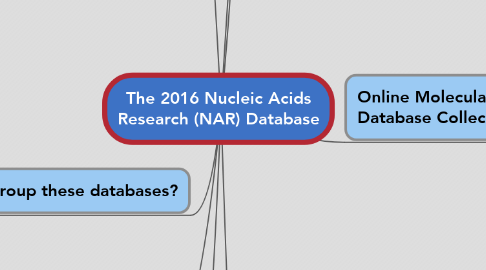
1. Why databases are created and shared?
1.1. Allow researchers to quickly find relevant information
1.2. Allow organised storage of large amount of information
1.2.1. Integration of multiple data sources
1.3. Data and information can be obtained easily
1.4. Easy data tracking and verification
1.5. Data can maintained for ongoing uses
1.6. Efficient manipulation of large data sets
1.7. Access of wide variety of biological relevant data
1.7.1. Cross-links/References to other resources
2. Criteria for selection into NAR databases
2.1. must present some novel development and meet the general criteria of originality, timeliness, significance and scientific excellence.
2.2. General utility and scientific quality of the database , comprehensiveness and coverage and degree of value added
2.3. Provide a detailed description of the recent and upcoming changes in this popular database
2.4. Comprehensive list of freely accessible, online tools, databases and resource materials for the bioinformatics and life sciences research communities
2.5. "boutique" databases
2.5.1. Covering relatively narrow topics
2.6. Update papers
2.6.1. only significant developments that warrant the publication
3. Why we need to group these databases?
3.1. Ensure consistency of information from different databases
3.1.1. Improved search sensitivity
3.2. Attempts to cope with the rapidly increasing amount of sequence data
3.3. Enable knowledge from different databases to be obtained with ease
3.4. Enable multi database mining
3.4.1. Joining of multiple data sets
3.5. Ensure data can be managed efficiently
3.5.1. Eg. Experimental results
4. Why some databases are no longer in the databases and dropped from it?
4.1. Reviewers can evaluate the papers
4.1.1. Taken away from NAR databases if found not valuable
5. Group 6 (Assignment 2) : 1. Choy OiYee 2. Chua SiewChin 3. Leong ChiaWeen 4. Kwek YanWei 5. Teo SengChong
6. Numbers available
6.1. Total : 1685 databases
6.1.1. 88 new resources added
6.1.2. Description of 62 newly created databases
6.1.3. Updates on 95 exisiting databases in NAR plus 17 described elsewhere
6.1.4. 121 non-responsive databases
6.1.4.1. 23 obsolete websites removed
7. Online Molecular Biology Database Collection
7.1. Contains 15 categories and 41 subcategories
7.2. Nucleic Acid Sequence and Structure
7.2.1. CEGA
7.2.1.1. Non-coding sequences but highly conserved (Potential promoters, enchancer and regulatory elements
7.2.2. JuncDB
7.2.2.1. Exon-exon junction sequences
7.2.3. dbSUPER & SEA
7.2.3.1. Super-enchancers sequences
7.2.4. Dfam
7.2.4.1. Human DNA repeated families
7.2.5. ARESite
7.2.5.1. AU-rich elements in vertebrates
7.2.6. NPIDB
7.2.6.1. Nuclear-protein interaction
7.2.7. JASPAR, HOCOMOCO, ORegAnno, RegulonDB
7.2.7.1. Transcriptional regulation
7.2.8. BIGNAsim
7.2.8.1. DNA dynamics (molecular dynamics simulation)
7.2.9. Various RNA databases
7.3. Protein sequence and Structure
7.3.1. NBDB
7.3.1.1. nucleotide binding motifs
7.3.2. UET
7.3.2.1. predicted protein functional sites
7.3.3. sORF
7.3.3.1. Proteomics databases
7.3.4. PRIDE & dbPTM
7.3.5. PDBe
7.3.6. Gene3D & FunTree
7.3.7. KLIFS
7.4. Metabolic and Signaling Pathways
7.4.1. KEGG, MetaCyc, Reactome, WIkiPathways, ECMDB, BiGG Models, MNXref/ MetaNetX
7.4.2. Metabolomics Workbench
7.4.2.1. Metabolomics data : metabolite standards, protocols, tutorials and analysis tools
7.5. Viruses, Bacteria, Protozoa and Fungi
7.5.1. BacDive
7.5.1.1. Organismal genome diversity
7.5.2. MG-RAST, EBI Metagenomics, probeBASE & Human Pan-Microbe Communities
7.5.2.1. Metagenomic resources
7.5.3. BacWGST
7.5.3.1. bacterial whole-genome sequences
7.6. Plants
7.6.1. IC4R
7.6.1.1. all aspects of rice research
7.7. Genomes of Human and Model Organisms
7.7.1. Ensembl, RefSeq, UCSC Genome Browser, ENCODE, SGD, Worm-Base, FlyBase, Hymenoptera Genome Databases
7.7.2. DMDD
7.7.2.1. phenotypic data of mouse mutant embryos
7.7.3. dbMAE
7.7.3.1. allele-specific expression of autosomal genes
7.8. Human Diseases and Drugs
7.8.1. ClinVar, GWASdb, HaploReg
7.8.1.1. Human genetic vartiation
7.8.1.2. Patented drugs, side effects, withdrawn drugs & potential drug target
7.8.2. DIDA
7.8.2.1. single nucleotide variants & small indels in specific pairs of gene
7.9. Others (Mitochondria, Chemical compounds databases)
7.9.1. PubChem, ChEBI, SureChEMBL
7.9.2. CSDB, GlyTouCan
7.9.3. MitoCarta, MitoMiner
7.9.3.1. mitochondrial proteins
7.9.4. MitoAge
7.9.4.1. Mitochondrial DNA properties

